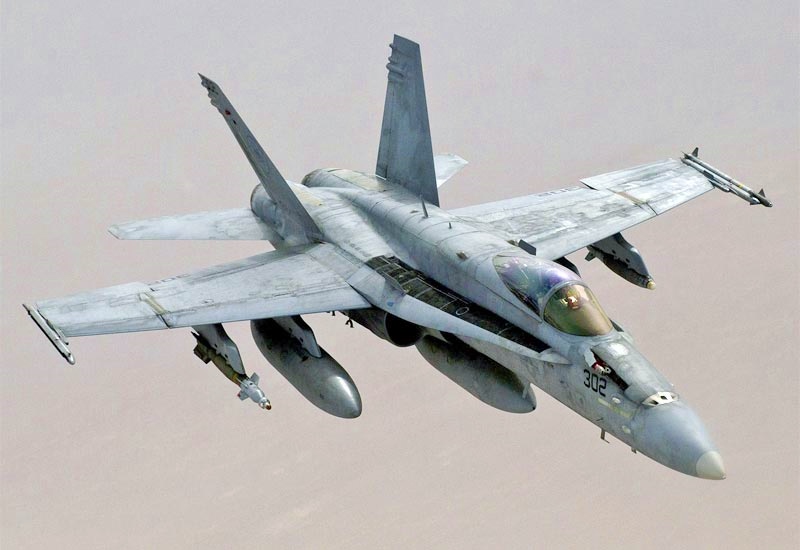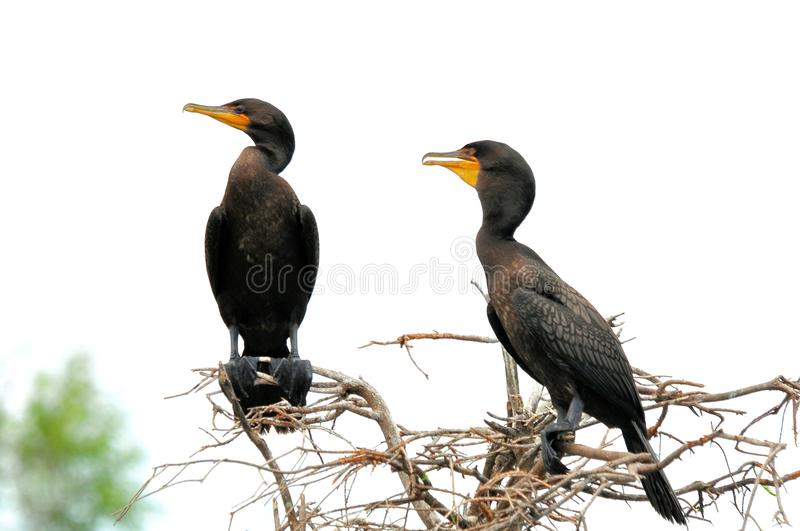
F / A-18 Hornet
F/A-18C from VFA-34 “Blue Blaster” squadron. The aircraft has a special livery prepared in connection with the last combat flight in the history of the US Navy Hornets, which took place aboard the aircraft carrier USS Carl Vinson from January to April 2018.
In April of this year, the US Navy (USN) officially stopped the use of F / A-18 Hornet airborne homing fighters in combat units, and in October, fighters of this type were withdrawn from training units of the Navy. The "classic" F/A-18 Hornet fighters are still in service with squadrons of the United States Marine Corps (USMC), which intends to operate them until 2030-2032. In addition to the United States, seven countries own F / A-18 Hornet fighters: Australia, Finland, Spain, Canada, Kuwait, Malaysia and Switzerland. Most intend to keep them in service for another ten years. The first user to remove them is likely to be Kuwait, and the last to be Spain.
The Hornet airborne fighter was developed for the US Navy jointly by McDonnel Douglas and Northrop (currently Boeing and Northrop Grumman). The flight of the aircraft took place on November 18, 1978. Nine single-seat aircraft, designated as F-9A, and 18 double-seat aircraft, designated as TF-2A, participated in the tests. The first tests on board the aircraft carrier - USS America - began in October 18 of the year. At this stage of the program, the USN decided that it did not need two modifications of the aircraft - a fighter and a strike. Hence the somewhat exotic designation "F / A" was introduced. The single seat variant was designated F/A-1979A and the double seat F/A-18B. The squadrons that were to receive the new fighters changed their letter designation from VF (Fighter Squadron) and VA (Strike Squadron) to: VFA (Strike Fighter Squadron), i.e. fighter-bomber squadron.
The F/A-18A/B Hornet was introduced to US Navy squadrons in February 1981. US Marine squadrons began receiving them in 1983. They replaced McDonnel Douglas A-4 Skyhawk attack aircraft and LTV A-7 Corsair II fighter bombers. , McDonnell Douglas F-4 Phantom II fighters and their reconnaissance version - RF-4B. Until 1987, 371 F / A-18As were produced (in production blocks 4 to 22), after which production switched to the F / A-18C variant. The two-seat variant, the F/A-18B, was intended for training, but these aircraft retained the full combat capabilities of the single-seat variant. With a longer cab, the B version can hold 6 percent of the internal tanks. less fuel than the single seat version. 39 F/A-18Bs were built in production blocks 4 to 21.
The flight of the F/A-18 Hornet multirole homing fighter took place on November 18, 1978. Until 2000, 1488 aircraft of this type were built.
In the early 80s, Northrop developed a land-based version of the Hornet, designated the F-18L. The fighter was intended for international markets - for recipients who intended to use them only from ground bases. The F-18L was devoid of "on-board" components - a landing hook, a catapult mount and a wing folding mechanism. The fighter also received a lighter chassis. The F-18L was significantly lighter than the F/A-18A, making it more manoeuvrable, comparable to the F-16 fighter. Meanwhile, Northrop partner McDonnel Douglas offered the F/A-18L fighter to international markets. It was only a slightly depleted variant of the F/A-18A. The offer was in direct competition with the F-18L, resulting in Northrop suing McDonnell Douglas. The conflict ended with McDonnell Douglas buying the F/A-50L from Northrop for $18 million and guaranteeing it the role of the main subcontractor. However, in the end, the base version of the F / A-18A / B was intended for export, which, at the request of the customer, could be removed from the on-board systems. However, the export Hornet fighters did not have the characteristics of a "specialized" land version, which was the F-18L.
In the mid-80s, an improved version of the Hornet was developed, designated F / A-18C / D. The first F/A-18C (BuNo 163427) flew on September 3, 1987. Externally, the F/A-18C/D was no different from the F/A-18A/B. Initially, Hornets F/A-18C/D used the same engines as the A/B version, i.e. General Electric F404-GE-400. The most important new components implemented in the C version were, among others, the Martin-Baker SJU-17 NACES Ejection Seats (Common Navy Crew Ejection Seat), new mission computers, electronic jamming systems, and damage-resistant flight recorders. The fighters were adapted for the new AIM-120 AMRAAM air-to-air missiles, AGM-65F Maverick thermal imaging guided missiles and AGM-84 Harpoon anti-ship missiles.
Since fiscal year 1988, the F/A-18C has been produced in the Night Attack configuration, allowing air-to-ground operations at night and in difficult weather conditions. The fighters were adapted to carry two containers: Hughes AN / AAR-50 NAVFLIR (infrared navigation system) and Loral AN / AAS-38 Nite HAWK (infrared guidance system). The cockpit is equipped with an AV/AVQ-28 head-up display (HUD) (raster graphics), two 127 x 127 mm color multifunctional displays (MFD) from Kaiser (replacing monochrome displays) and a navigation display displaying a digital, color, moving Smith Srs map 2100 (TAMMAC - Tactical Aircraft Moving Map Capability). The cockpit is adapted for the use of GEC Cat's Eyes (NVG) night vision goggles. Since January 1993, the latest version of the AN / AAS-38 container, equipped with a laser target designator and a range finder, has been added to the equipment of the Hornets, thanks to which Hornets pilots could independently indicate ground targets for laser guidance. weapons (own or carried by other aircraft). The prototype F / A-18C Night Hawk took off on May 6, 1988. Production of the “night” Hornets began in November 1989 as part of the 29th production block (out of the 138th instance).
In January 1991, the installation of new General Electric F36-GE-404 EPE (Enhanced Performance Engine) engines began as part of production block 402 in Hornety. These engines generate about 10 percent. more power compared to the "-400" series. In 1992, the installation of a more modern and powerful Hughes (now Raytheon) type AN / APG-18 airborne radar was started on the F / A-73C / D. It replaced the originally installed Hughes AN/APG-65 radar. The flight of the F / A-18C with the new radar took place on April 15, 1992. Since then, the plant began to install the AN / APG-73 radar. In parts produced since 1993, the installation of four-chamber anti-radiation launchers and AN / ALE-47 thermal jamming cassettes, which replaced the older AN / ALE-39, and an upgraded AN / ALR-67 radiation warning system, have begun. .
Initially, the Night Hawk upgrade did not include the two-seat F/A-18D. The first 29 copies were produced in a combat training configuration with the basic combat capabilities of the Model C. In 1988, by special order of the US Marine Corps, an attack version of the F / A-18D was released, capable of operating in all weather conditions. was developed. The rear cockpit, devoid of a control stick, was adapted for combat system operators (WSO - Weapons Systems Officer). It has two side multi-functional joysticks for controlling weapons and on-board systems, as well as a movable map display located above on the control panel. The F/A-18D received a complete Night Hawk model C package. A modified F/A-18D (BuNo 163434) flew in St. Petersburg. Louis 6 May 1988 The first production F/A-18D Night Hawk (BuNo 163986) was the first D model built on the Block 29.
The US Navy has ordered 96 F/A-18D Night Hawks, most of which have become part of the all-weather Marine Corps.
These squadrons are marked VMA (AW), where the letters AW stand for All-Weather, meaning all weather conditions. The F/A-18D replaced primarily the Grumman A-6E Intruder attack aircraft. Later, they also began to perform the function of the so-called. air support controllers for fast and tactical air support - FAC (A) / TAC (A). They replaced the McDonnell Douglas OA-4M Skyhawk and North American Rockwell OV-10A/D Bronco aircraft in this role. Since 1999, the F/A-18D has also taken over the tactical aerial reconnaissance missions previously performed by the RF-4B Phantom II fighters. This was made possible thanks to the introduction of the Martin Marietta ATARS (Advanced Tactical Airborne Reconnaissance System) tactical reconnaissance system. The "palletized" ATARS system is installed in the chamber of the M61A1 Vulcan 20 mm multi-barrel gun, which is removed during the use of ATARS.
Aircraft with the ATARS system are distinguished by a characteristic fairing with windows protruding under the nose of the aircraft. The operation to install or remove ATARS can be completed in a few hours in the field. The Marine Corps has allocated ok.48 F / A-18D for reconnaissance missions. These aircraft received the unofficial designation F/A-18D (RC). Currently, reconnaissance Hornets have the ability to send photographs and moving images from the ATARS system in real time to ground recipients. The F/A-18D(RC) has also been adapted to carry Loral AN/UPD-8 containers with an airborne side-looking radar (SLAR) on the center fuselage pylon.
On August 1, 1997, McDonnell Douglas was acquired by Boeing, which has since become "brand owner". The production center of the Hornets, and later the Super Hornets, is still located in St. Petersburg. Louis. A total of 466 F/A-18Cs and 161 F/A-18Ds were built for the US Navy. Production of the C/D model ended in 2000. The last series of F / A-18C was assembled in Finland. In August 2000, it was handed over to the Finnish Air Force. The last Hornet produced was the F/A-18D, which was accepted by the US Marine Corps in August 2000.
Modernization “A+” and “A++”
The first Hornet modernization program was launched in the mid-90s and included only the F / A-18A. The fighters were modified with AN / APG-65 radars, which made it possible to carry AIM-120 AMRAAM air-to-air missiles. The F/A-18A has also been adapted to carry the AN/AAQ-28(V) Litening surveillance and targeting modules.
The next step was the selection of about 80 F / A-18A with the longest resource and airframes remaining in relatively better condition. They were equipped with AN / APG-73 radars and individual elements of C avionics. These copies were marked with the A + sign. Subsequently, 54 A+ units received the same avionics package as was installed in the C model. They were then marked F/A-18A++. Hornets F / A-18A + / A ++ were supposed to complement the fleet of F / A-18C / D. As the new F / A-18E / F Super Hornet fighters entered service, some A + and all A ++ were transferred by the US Navy to the Marine Corps.
The US Marines also put their F/A-18A through a two-stage modernization program, which, however, was somewhat different from the US Navy's. Upgrading to A+ standard included, among other things, the installation of AN/APG-73 radars, GPS/INS integrated satellite-inertial navigation systems, and the new AN/ARC-111 Identification Friend or Foe (IFF) system. The sea hornets equipped with them are distinguished by characteristic antennae located on the nose in front of the fairing (literally called "bird cutters").
At the second stage of modernization - to the A ++ standard - the USMC Hornet was equipped, including in color liquid crystal displays (LCD), JHMCS helmet displays, SJU-17 NACES ejection seats and AN / ALE-47 blocking cartridge ejectors. The combat capabilities of the F / A-18A ++ Hornet are practically not inferior to the F / A-18C, and according to many pilots even surpass them, as they are equipped with more modern and lighter avionics components.
